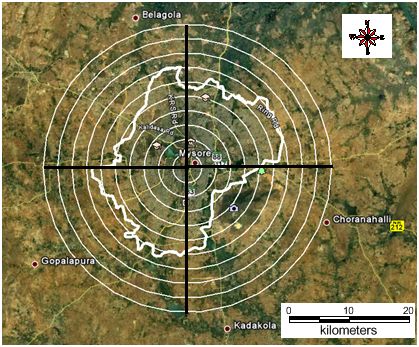METHOD

Figure 2. Procedure followed to understand the spatial pattern of landscape change
A two-step approach has been adopted to chart the direction of the City’s development. A normative approach to understand the land use and the pattern of growth in past 4 decades, complemented by a gradient approach of 1km radius.
Preprocessing: The remote sensing data obtained were geo-referenced, rectified and cropped pertaining to the study area. The Landsat satellite 1973 images have a spatial resolution of 57.5 m x 57.5 m (nominal resolution) were resampled to 28.5m comparable to the 1989 - 1999 data which are 28.5 m x 28.5 m (nominal resolution). IRS P6 image was obtained from NRSC, Hyderabad and has a spatial resolution of 5.6m.
Landcover Analysis: To understand the changes in the vegetation cover Normalised Difference Vegetation index (NDVI) was computed for all images. Itsvalue ranges from values -1 to +1. Very low values of NDVI (-0.1 and below) correspond to soil or barren areas of rock, sand, or urban builtup. Zero indicates the water cover. Moderate values represent low density vegetation (0.1 to 0.3), while high values indicate thick canopy vegetation (0.6 to 0.8).
Land use analysis: The geometricaly corrected and processed data is classified using supervised classification method by the aid ofMaximum likelihood algorithm. The image was classified using signatures from training sites that include all the landuse types detailed in Table 2. Signatures collected represented all four classes and were covering atleast 75% of the total Mysore city. Then the signatures were digitized as polygons of the signatures with the help of Google earth and Bhuvan. Then these polygons were overlaid on the data to provide better accuracy in digitizing. This involves generation of false color composite of remote sensing data (bands – green, red and NIR), this helps us in visualising the heterogeneous patches in the landscape and then overlaying it. Maximum Likelihood classifier is then used to classify the data using these signatures generated.This method has already been proved as a superior method as it uses various classification decisions using probability and cost functions (Duda et al., 2000). Mean and covariance matrix are computed using estimate of maximum likelihood estimator.Land Use was computed using the temporal data through a free and open source program GRASS - Geographic Resource Analysis Support System (http://wgbis.ces.iisc.ac.in/grass/welcome.html). 70% of the total generated signatures were used in classification, 30% signatures were used in validation and accuracy assessment. Classes of the resulting image were reclassed and recoded to form four land-use classes.
Table 2. Land use classification categories adopted
Land use Class |
Land uses included in the class |
Urban |
This category includes residential area, industrial area, and all paved surfaces and mixed pixels having built up area. |
Water bodies |
Tanks, Lakes, Reservoirs. |
Vegetation |
Forest, Cropland, nurseries. |
Others |
Rocks, quarry pits,open ground at building sites, kaccharoads. |
Accuracy assessment methods evaluate the performance of classifiers (Song et al., 2001; Gao and Liu, 2008). This is done either through testing the statistical significance of a difference, comparison of kappa coefficients (Congalton et al., 1983, Redmond and Heneghan 2006, Liu et al., 2007) or proportion of correctly allocated classes (Gao & Liu, 2008). For the purpose of accuracy assessment, a confusion matrix was calculated. Accuracyassesment, Kappa coefficient, are common measurementsused in various publications to demonstrate the effectiveness of the classifications (Congalton, 1983; Congalton, 1991; Lillesand & Kiefer, 2000).
Density Gradient Analysis: In order to understand the pattern of growth in the city, the city has been divided into 4 zones based on directions (North, South, East and West). As most of the definitions of a city or its growth is defined in directions it was considered more appropriate to divide the regions in 4 zones based on direction. The classified image is then divided into four zones based on four directions based on the Central pixel (Central Business district). The zones are named as– Northwest (NW), Northeast (NE), Southwest (SW) and Southeast (SE) respectively (Figure 2). The growth of the urban areas was understood in each zone separately through the computation of urban density for different periods.
Division of these zones to concentric circles and computation of metrics: Further each zone was divided into concentric circle of incrementing radius of 1 km (figure 2) from the center of the city would help in visualizing the changes at neighborhood level. This also helps in understanding the agents responsible for changes. This helps in identifying the causal factors and locations experiencing various levels of urbanization in response to the economic, social and political forces and visualizing the forms of urban sprawl. The built up density in each circle is monitored overtime using time series analysis.

Figure 2. Google earth representation of the study region
Computation of Shannon’s Entropy: To determine whether the growth of urban areas was compact or divergent the Shannon’s entropy (Yeh and Liu, 2001; Li and Yeh, 2004; Lata et al., 2001; Sudhira et al., 2004; Pathan et al., 2004) was computed for each zones. Shannon’s entropy (Hn) given in equation 1, gives us an insight into how to development in the city are happening (either the growth is clumped or is it distributed sparsely) and its connection with geographical variables among ‘n’ concentric circles across Zones.
 …… (1)
…… (1)
Where Pi is the proportion of the built-up in the ith concentric circle. As per Shannon’s Entropy, if the distribution is maximally concentrated in one circle the lowest value zero will be obtained. Conversely, if it is an even distribution among the concentric circles will be given maximum of log n.




 …… (1)
…… (1)